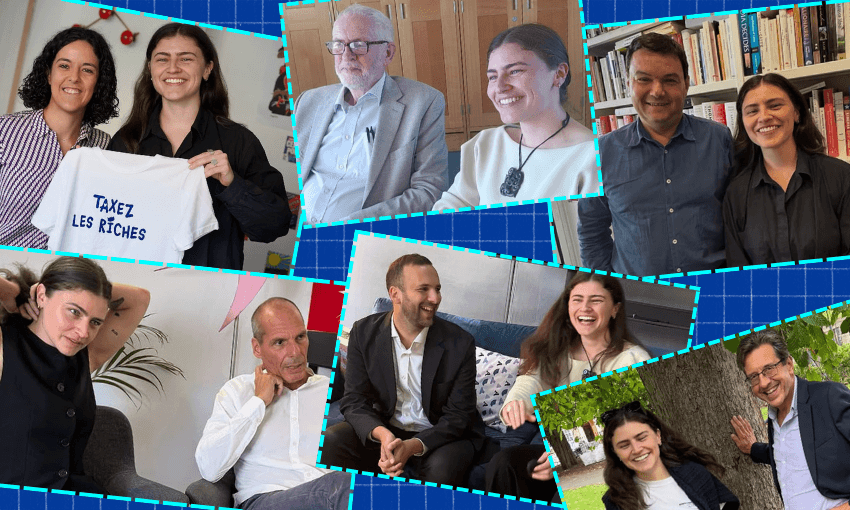A council plan released today could transform Auckland’s creaking transport infrastructure while slashing greenhouse gases and making the city safer for all, writes accessibility and sustainable transport advocate Tim Adriaansen.
This week Auckland Council will vote on what may be the most transformational policy Tāmaki Makaurau has ever seen.
The Transport Emissions Reduction Pathway, or TERP, sets out a plan to reduce Auckland’s greenhouse gas emissions at the same time as New Zealand’s biggest city is growing in both size and population. Transport is the region’s biggest source of climate-changing emissions, so the TERP will need to call for a huge reduction in the amount of petrol and diesel burned up in our vehicle’s engines.
This will require far more walking, cycling and public transport. It will require electric cars, trucks, buses and ferries. It will also require Aucklanders to drive less. A lot less. If the number-crunching climate action advocates are correct, every person in Auckland will spend around 75% less time sitting in a car in 2030 compared to what we do today.
For Auckland, this is an opportunity to create a transport system that provides options for everyone.
We can slash air pollution, smash heart disease and not crash into things nearly as often. Lower income families won’t be burdened with the high costs of car ownership. By adopting principles of universal access, we can improve opportunities for children, elderly and disabled people. Chances are that for most of us, we’ll be able to get where we’re going much more quickly, too. We can all be happier, healthier and wealthier.
A few Auckland residents didn’t seem so convinced by this approach when the parking strategy – a plan to make better use of just 3.25% of Auckland’s roads – came before council earlier this year. The plan became so contentious that its final approval was delayed until after the election, avoiding the need for councillors to make a decision while they’re busy trying to win votes.
Where the parking strategy was more of a storm in a teacup, the Transport Emissions Reduction Pathway is a seven-course degustation. Council’s Environment and Climate Change Committee, where the TERP will be debated, has recognised that we’ve already spent enough time talking about reducing emissions and that, election or no election, Auckland Transport needs to be given a clear mandate to actually get to work.
After all, climate change shouldn’t be a contentious issue. Councillors unanimously voted to adopt Te Tāruke-ā-Tāwhiri: Auckland’s Climate Plan, which called for a 64% reduction in emission from transport by the end of the decade. With around three-quarters of Aucklanders reporting growing concern about climate change, it would be politically risky and morally bankrupt for a councillor to openly oppose actually following that plan, this close to the election.
The TERP became necessary when, despite the clear transport objectives in Te Tāruke-ā-Tāwhiri, Auckland Transport threw the widely consulted strategy into the ever-rising ocean by producing a 10-year investment plan that would see emissions from transport increase, rather than decrease.
When challenged in court over the significant difference between what Auckland Transport were asked to do and what they actually planned to do, lawyers acting for council took a pyrrhic victory when they went on to successfully trash their client’s own climate plans. This week’s adoption of the TERP is a shot at redemption.
Perhaps some councillors will complain that while they voted for transformational climate action, they didn’t expect to actually have to follow through on that promise. No doubt some charlatans will wail and gnash at the thought of anything other than a car-saturated city. But if anybody should be embracing the TERP, it’s people who need to drive.
Think of it like this: Whenever you’re stuck in traffic, what’s really holding you up is the number of other drivers on the road. We might think that widening the road or adjusting an intersection to shift more traffic would solve the problem, but this is a fool’s errand. Every time we make it easier to drive, people respond by – unsurprisingly – driving more. Too many people driving is exactly the cause of our traffic problems—and our carbon problems.
This is known as induced demand, the phenomenon by which investing in roads inevitably makes traffic worse. Thankfully, there is an alternative.
The very best transport system for drivers is one where there are well-maintained roads which go everywhere we need to go, and nobody else driving on them; where the courier driver dropping off packages doesn’t have to compete for space with a light truck travelling two minutes to the dairy. The very best transport plan, then, is the one which gives people good options to get around, and driving is low down on the list.
We don’t need to do this by making driving worse. We can do it by making everything else better. Most of the time, there will be a trade-off. We have neither the time nor the money to rebuild every piece of Auckland’s nearly 8,000 kilometres of roading network. We’ll need to work smarter, not harder; and we’ll need to get the best out of the tools we’ve already got.
The Transport Emissions Reduction Pathway offers the best chance we’ve ever had to beat traffic in Auckland – and if we treat this as the opportunity that it is, we can build a better world while we’re at it.
The Transport Emissions Reduction Pathway is scheduled to by published at 12pm today.





